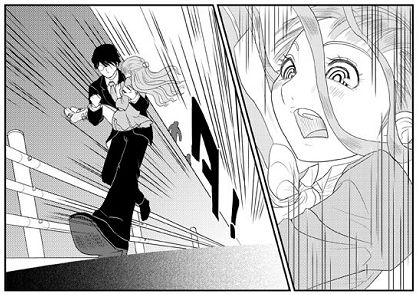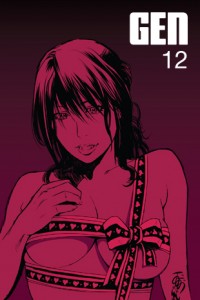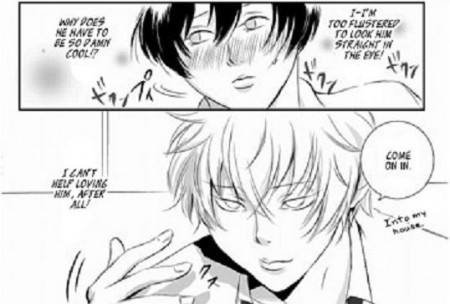Gen Issue 12 Review
Exactly a year ago GEN debuted as a new experimental effort to introduce original Japanese doujinshi to English speaking readers. Unlike earlier American publishing efforts that had published pornographic Japanese doujinshi or parodies of well-known anime, GEN published exclusive manga created by talented independent Japanese artists specifically for English translation and publication in GEN. A year and twelve issues in, GEN has steadily improved from its admirable debut, including select original manga from published professional Japanese manga authors, and elevating from an introductory anthology of amateur manga to a must-read primer of Japanese alternative, underground, and seinen drama manga for introspective and literate young adult readers. The twelth issue of GEN continues the unique and unconventional “Alive” manga story and debuts the second chapters of four stories introduced in last month’s issue.

The second chapter of Kosuke Kabaya’s “Android Angels” develops its story with situations and fresh character development but few answers. The story of an heiress protected by a handsome android with a mysterious past evokes better known manga tales including Kuroshitsuji and Inu x Boku SS, yet Android Angels is distinctly different from other familiar tales because of its combination of shoujo tone with vintage sci-fi manga style. As much as the look and tone of the story evoke the floral romance manga of Moto Hagio, the art design and development are also distinctly reminiscent of Shotaro Ishinomori’s Cyborg 009 and Noboru Kawasaki’s artwork in Kyojin no Hoshi. Unfortunately, while the art is crisp and attractive by doujin standards, character poses and action shots are a bit stiff. While the visual art wants to depict fluid motion, panels often look static.
While the first chapter of artist love’s “One is Enough” introduced seeming seme & uke boy-love romance characters, the story’s second chapter confirms beyond any doubt that “One is Enough” is a straightforward coming-of-age and coming-out story about a sixteen-year-old boy realizing that his first love is a boy one year older than himself. The story is an interesting addition to the GEN lineup, bringing yaoi into the increasing eclectic mix of genres the anthology represents. The story focuses heavily on its protagonist, and in this chapter doesn’t push its sexual activity very far, making the story engaging for fujoshi and easily accessible for readers not used to gay-love manga stories. The graphic art uses screentone and lots of visual enhancements effectively to fill the page and make the story lively, but inconsistency in character design reveals the artist’s inexperience.
The second chapter of Isora Azumi’s “Stones of Power” focuses primarily on narrative development, which leaves character insight a bit minimal and superficial. However, in only two chapters, some compromise is necessary and easily excusable. In its second chapter, the story fully reveals itself as a unique contemporary fantasy about a fish tank with cosmic significance. The visual art is sharp and crisp, effectively enhancing the atmosphere of hurried daily life overlooking slower-paced but far more important subtelties. The English translation likewise indulges and encourages astute, contemporary readers by keeping Japanese nuances like honorables (“ne-sama” & “-kun”), Japanese name order, and the managerial title “master” intact. The story requires a bit of reader interpretation, and allows readers to form indepenent opinions about the characters and their motivations, which makes the story engaging, and gives it a bit more of a mature tone than many conventional manga.
The “Keiken Sosa” chapter of Nukuhara’s ongoing manga “Anomal” is another self-contained story completely unrelated to the previous issue’s installment. The undercurrent of humor present in the first story comes to the forefront in the second tale, a comical story revolving around a genius police detective with a pronouned scopophobia and a unique yet highly effective method of solving crimes. The refined and attractive visual art is reminiscent of particularly Haruaki Kato’s Hyakko, as is the lighthearted tone. Carrying forward the theme introduced earlier in the “One is Enough” chapter, the “Keiken Sosa” story also includes a hint of yaoi, although this one used for comic rather than romantic ends. The oddball investigator Naegi and his new partner Okabu-kun are amusing characters that seem a shame to be relegated to a one-off story. Hopefully readers will be treated to more of their unusually “hands on” crime scene investigations in the future.
The latest installment of Hajime Taguchi’s “Alive” consists of three short stories. “I’ll Give You a Name” is a playful, disposable tale of a teen girl who gets committed to more than she expected after meeting a talking frog. In a pleasant irony, this man versus nature parable suggests that human nature isn’t always at odds with environmental nature. The visual art is a bit rough, but the breezy narrative doesn’t demand heavy duty line work. Japanese text is selectively translated, which creates a striking visual contrast, but the decision over which Japanese text to translate and which to leave unaltered is obviously thoughtful and done to heighten readability. The “Thus, We Are Dirtied” story evokes anime’s prominent theme of youth versus adulthood but ultimately has little to say about the conflict. “Will” resurrects the philosophical melancholy that typifies the “Alive” series, satirically condemning reality in the face of idealism. This short tale that concludes the first year of GEN is a perfect capstone, an unusual tale that turns convention upside down and forces readers to evaluate their ethical and philosophical beliefs, just as GEN itself encourages readers to expand and undo their conventional perception of Japanese manga.
The twelfth issue of GEN is more lighthearted and benign than usual of the anthology, but the issue pushes the anthology forward in a new direction by representing new narrative genres and themes previously unseen in the anthology. GEN is a rewarding and satisfying peek into the beating heart of contemporary Japanese manga culture, revealing creative and provocative stories from grassroots Japanese artists. These stories are well suited for typical American manga readers, but are also edifying for older readers and manga fans interested in expanding their appreciation of eclectic and unconventional manga.






